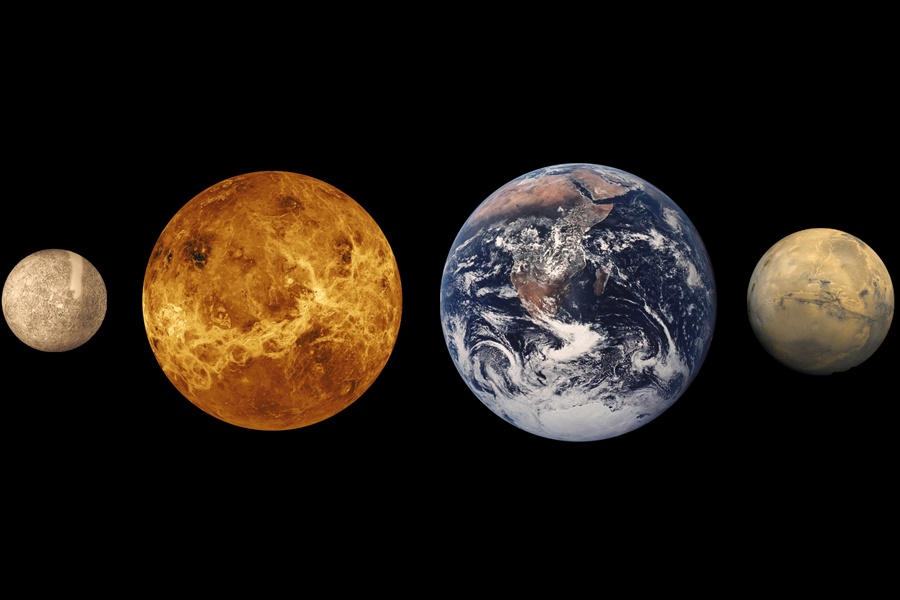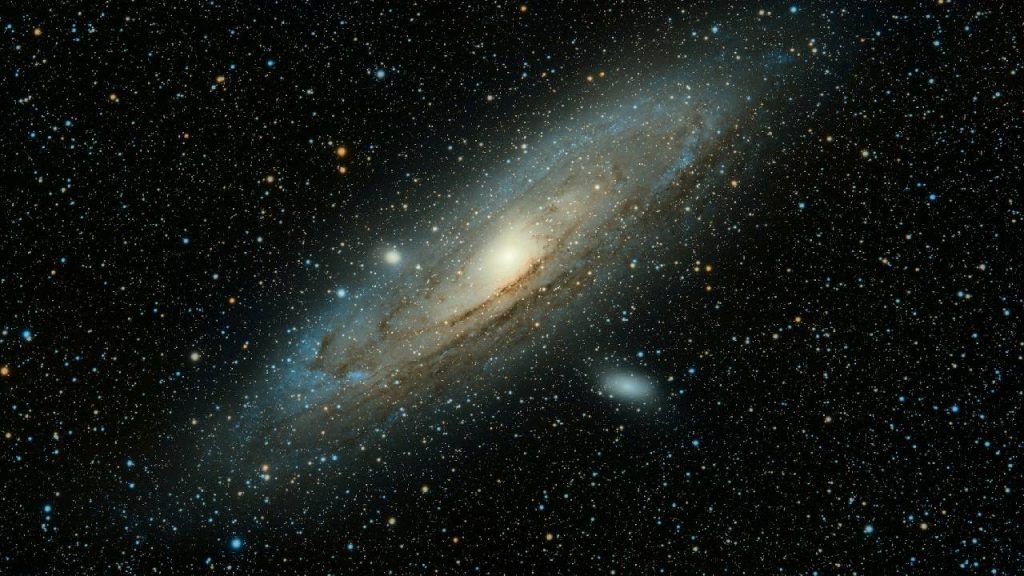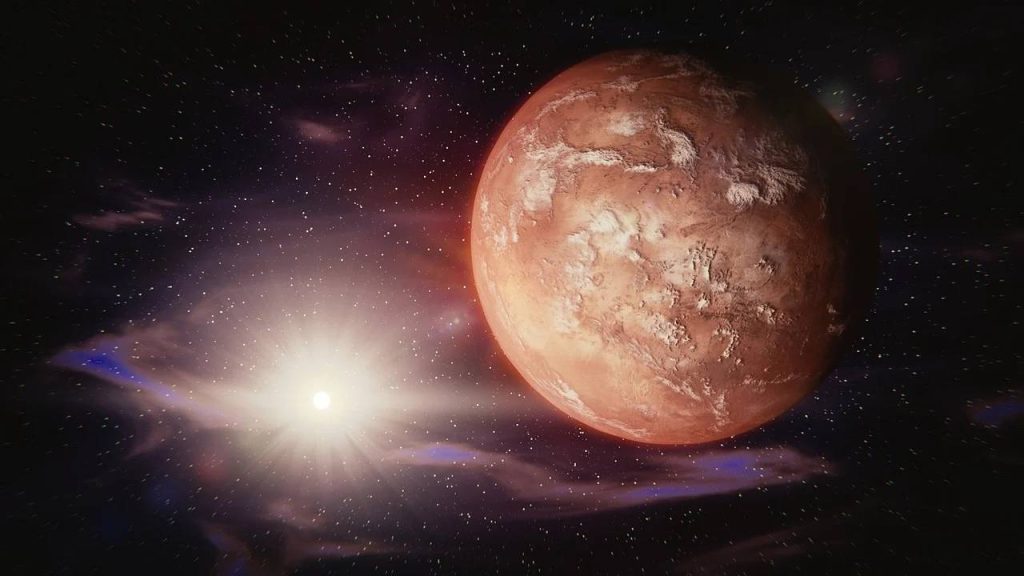While the Universe boasts an array of celestial wonders, many are interested in understanding the planets. Our solar system has eight planets, yet only a few resemble Earth. This exclusive group is known as ‘terrestrial planets’ distinguished by their solid surfaces that may mirror our planet Earth’s features. But what are terrestrial planets?
Each planet has its own story, from the blistering heat of Venus to the dusty plains of Mars. By the end, you will have a clearer picture of what makes these rocky planets unique and why they matter in our solar system.
What Are the Terrestrial Planets?
Terrestrial planets are the rocky planets — Mercury, Venus, Earth, and Mars. They do not have rings like Saturn or are super colorful like Jupiter, but they’re a distinct class of planets in our solar system characterized by their solid, rocky surfaces.
They are also relatively smaller in size than the gas giants and have thin atmospheres. The terrestrial planets typically have fewer moons compared to the gas giants.

Terrestrial vs. Gas Giant Planets
When exploring the celestial bodies within our solar system and beyond, a fundamental distinction arises between terrestrial and gas giant planets. Here are the key differences that set these two categories apart.
Terrestrial planets
- Terrestrial planets are characterized by their rocky composition, resembling Earth in many ways.
- They typically have solid surfaces with diverse geological features such as mountains, valleys, and impact craters.
- Terrestrial planets are closer to the Sun, resulting in higher temperatures and greater temperature variations.
- Earth, Mercury, Venus, and Mars are the terrestrial planets in our solar system.
Gas giant planets
- Gas giant planets are composed mainly of gases and lack a solid surface.
- These planets have thick atmospheres primarily composed of hydrogen and helium, with traces of other elements.
- Gas giants are located farther from the Sun, resulting in colder temperatures on their surfaces.
- Neptune, Uranus, Jupiter, and Saturn are the gas giants in our solar system, known for their massive size and intricate ring systems.
Composition and Characteristics of the Terrestrial Planets
As we explore the terrestrial planets in our solar system, it’s essential to understand the key characteristics that set them apart from gas giants. Let’s delve into the size and composition, atmospheres, and surface features of these rocky worlds.
Size and composition
- Mercury — It is the smallest of the terrestrial planets, with a diameter of approximately 4,880 kilometers (3,030 miles). It consists mainly of a metal-rich core, making up a substantial portion of its overall composition.
- Venus — It is often called Earth’s “sister planet” due to its similar size. It boasts a diameter of around 12,104 kilometers (7,521 miles) and has a rocky composition with a significant iron-nickel core.
- Earth — It is the largest of the terrestrial planets, with a diameter of about 12,742 kilometers (7,918 miles). It is distinguished by its diverse geology and a substantial atmosphere, including life-sustaining oxygen.
- Mars — It, also known as the “Red Planet,” has a diameter of roughly 6,779 kilometers (4,212 miles). Its composition includes iron and magnesium silicates and a thin atmosphere primarily composed of carbon dioxide.
Atmospheres
- Mercury — Its atmosphere is nearly nonexistent, consisting mainly of trace amounts of hydrogen, helium, and small amounts of other elements. Its lack of a significant atmosphere contributes to its extreme temperature variations.
- Venus — It possesses a thick and toxic atmosphere dominated by carbon dioxide with sulfuric acid clouds. This atmosphere produces an intense greenhouse effect, leading to extreme surface temperatures.
- Earth — It boasts a life-sustaining atmosphere composed primarily of nitrogen (about 78%), oxygen (about 21%), and trace gases. This atmosphere provides a stable climate and supports diverse life forms.
- Mars — It has a thin atmosphere primarily composed of carbon dioxide (around 95%) with traces of nitrogen and argon. Its atmosphere is not thick enough to maintain a stable climate or support liquid water on the surface.
Surface features
- Mercury — Its surface is heavily cratered, resembling the Moon‘s landscape. It features vast plains and cliffs formed as the planet’s surface cooled and contracted.
- Venus — It exhibits vast volcanic plains and highland regions. Numerous impact craters and mountains mark its surface. Venusian volcanoes and its unique tesserae terrain are of particular interest.
- Earth — Its surface is incredibly diverse, featuring continents, oceans, mountains, valleys, and a wide range of ecosystems. It is the only known planet with abundant liquid water, which is critical for supporting life.
- Mars — It showcases a variety of surface features, including the largest volcano in the solar system, Olympus Mons, and the vast Valles Marineris canyon system. Evidence of ancient river valleys and polar ice caps adds to its geological intrigue.
Types of Terrestrial Planets
Solar terrestrial planets
Within our solar system, terrestrial planets are a unique category of celestial bodies that offer a glimpse into the potential for life beyond Earth. Let’s explore the solar terrestrial planets in more detail.
Earth
Earth is the only known planet with abundant liquid water on its surface, a vital ingredient for life. It boasts a diverse range of ecosystems and is teeming with various life forms.
Furthermore, the Earth’s dynamic geology is characterized by tectonic plate movements, which shape continents, create mountains, and lead to volcanic activity.
Mercury
Mercury, the innermost planet, is known for its extreme temperature variations, with scorching days and frigid nights. It lacks a substantial atmosphere, exposing its surface to the harshness of space. Mercury’s surface also includes vast plains, towering cliffs, and a large impact basin known as the Caloris Basin.
Venus
Venus, often referred to as Earth’s “sister planet,” has a thick and toxic atmosphere primarily composed of carbon dioxide. The intense greenhouse effect on Venus results in surface temperatures hot enough to melt lead.
Moreover, the surface features of Venus include extensive volcanic plains and highland regions, as well as unique tesserae terrain.
Mars
Mars, often called the “Red Planet” due to its reddish appearance, has a thin atmosphere primarily composed of carbon dioxide. Evidence suggests the presence of liquid water in the distant past, hinting at the possibility of ancient Martian life.
Additionally, the surface features include the largest volcano in the solar system, Olympus Mons, and the vast Valles Marineris canyon system.
So, though diverse in their characteristics, these solar terrestrial planets offer valuable insights into the potential for life and the geological processes that shape rocky worlds within our solar system.
Extrasolar terrestrial planets
Beyond our solar system, in the vast expanse of the Milky Way and other galaxies, astronomers have made exciting discoveries of extrasolar terrestrial planets, often referred to as exoplanets.
Extrasolar terrestrial planets, or exo-terrestrials, are rocky planets located outside our solar system. They share common characteristics with our solar terrestrial planets, such as solid surfaces and the potential for supporting life.
Exoplanets come in a wide range of sizes and compositions, with some resembling Earth in terms of size and rocky composition.
Scientists search for exoplanets within the habitable zone of their host stars, where conditions might allow for liquid water and the potential for life. Telescopes and advanced detection methods have enabled astronomers to identify thousands of exoplanets, expanding our understanding of cosmic planetary diversity.
Challenges and future discoveries
The study of exoplanets presents unique challenges, including the need for advanced observational techniques to detect these distant worlds.
Ongoing research aims to identify exoplanets with Earth-like characteristics, offering tantalizing prospects for finding potentially habitable environments beyond our solar system.
The exploration of both solar terrestrial planets and extrasolar terrestrial planets continues to captivate astronomers and space enthusiasts alike, fueling our curiosity about the potential for life elsewhere in the universe.

Potential for Life on Terrestrial Planets
When pondering terrestrial planets, the question of life naturally arises. While these rocky worlds may appear inhospitable, the potential for life, either in the past or present, remains a captivating subject of scientific inquiry.
This exploration falls under astrobiology, a multidisciplinary field dedicated to understanding the conditions and possibilities for life beyond Earth.
Biological mysteries
Ancient Mars
Mars has long fascinated scientists with its enigmatic history. Evidence of ancient river valleys and lake beds suggests that liquid water once flowed on its surface, making it a candidate for past microbial life. So, modern Mars missions seek further clues.
Venus’s high-altitude mysteries
Despite Venus’s harsh surface conditions, scientists have raised intriguing questions about the possibility of life in its upper atmosphere, where temperatures and pressures are milder. Microbial life could potentially exist within Venus’s cloud layers.
Extremophiles on Earth
Researchers have discovered extremophiles — organisms thriving in extreme environments — on Earth, such as deep-sea hydrothermal vents and acidic hot springs. Studying these resilient life forms provides insights into potential life on terrestrial planets.
Search for biosignatures
Scientists are actively seeking biosignatures — indicators of past or present life — on terrestrial planets. These could include the presence of complex organic molecules, unique mineral formations, or unusual atmospheric compositions.
The importance of liquid water
Liquid water is a key ingredient for life as we know it. Understanding the history of water on terrestrial planets and its potential presence today is critical to assessing their habitability.
Geological mysteries
The geological landscapes of terrestrial planets hold countless mysteries, enticing scientists to unravel their secrets.
The Martian Methane mystery
Mars has exhibited occasional spikes in atmospheric methane levels, a gas that can be produced by geological processes or living organisms. Investigating the source of these methane emissions is an ongoing scientific puzzle.
Venusian volcanoes
Venus showcases a complex history of volcanic activity, with extensive plains and volcanic structures. The exact mechanisms driving its volcanic eruptions and their implications for the planet’s geological evolution remain subjects of study.
Mars’s missing water
Despite evidence of ancient river valleys and lake beds, Mars’s current water inventory is significantly depleted. Understanding where its water went and whether it still exists underground is a fundamental geological enigma.
Mercury’s enigmatic magnetic field
Mercury, the closest terrestrial planet to the Sun, defies expectations with its weak magnetic field. Exploring the origin and persistence of this magnetic field challenges your understanding of planetary magnetism.
Mars’s Recurring Slope Lineae (RSL)
These dark streaks on Martian slopes appear seasonally and suggest the presence of liquid water. Investigating the formation and disappearance of RSL raises questions about Martian geophysics.
Overall, these mysteries and the ongoing quest to decipher them ignite scientific curiosity and drive exploration missions to terrestrial planets. Our knowledge of these rocky worlds expands with each discovery, unveiling the captivating stories written across their surfaces and deep within their cores.

Frequently Asked Questions
What planets are Jovian and terrestrial?
Planets fall into two primary categories: Jovian (gas giants) and terrestrial (rocky worlds). Jupiter and Saturn are Jovian giants in our solar system, massive and gas-dominated. Terrestrial planets with solid surfaces include Mercury, Venus, Earth, and Mars.
Are there plans for future Venus missions?
Yes, space agencies plan missions to explore Venus. NASA and others aim to study its mysteries, like the extreme greenhouse effect and volcanic activity. These missions will uncover Venus’s history and aid future human exploration.
Why is Mars’ atmosphere significant for colonization?
Mars’s thin atmosphere offers some cosmic radiation and meteor impact protection. It contains carbon dioxide that can be converted into oxygen, critical for human survival. Understanding Mars’ atmosphere is vital for planning human-crewed missions and habitats.
Do all terrestrial planets have magnetic fields?
No, not all. Earth, Mercury, and Mars have magnetic fields, while Venus lacks one. These fields shield planets from the solar wind’s charged particles and influence internal structure. Studying magnetic fields helps decipher a planet’s history and habitability.
Conclusion
What are the terrestrial planets? In this cosmic journey, we’ve uncovered the essence of terrestrial planets, the rocky cousins of our Earth within our solar system. Though diverse in their features and atmospheres, Mercury, Venus, Earth, and Mars share the common ground of solid surfaces. They offer insights into the possibilities of life beyond our home planet and remind us of the intricacies of planetary geology and atmospheres.
Contrasting these terrestrial worlds, the gas giants of our solar system, Jupiter and Saturn, reside far from the Sun and are shrouded in thick atmospheres. This distinction illustrates the breadth of planetary diversity within our celestial neighborhood.
While challenges persist in their detection and characterization, the pursuit of exoplanets with Earth-like qualities promises exciting revelations in the quest for habitable environments beyond our solar system.
